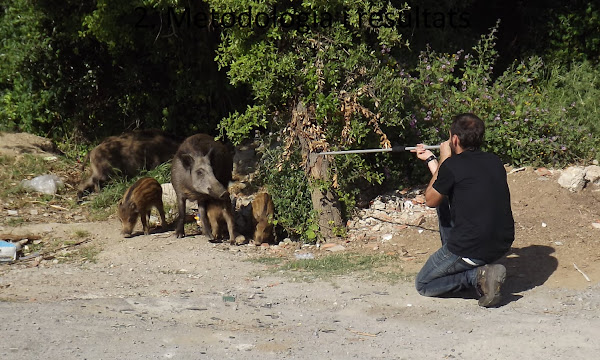Wild boar now number more than 10m in the EU, the group says. “Conflicts between humans and wild boar will increase”, says Baños. The numbers are putting more pressure on cities to manage the population of a pest that’s bigger than a rat, with behaviours more complex than a pigeon or stray cat.
Boar eradication strategies have been trialled, including contraception, poison and selective culling. In Berlin, the city pays a team of stadtjäger, or trained street hunters, to pick off nuisance wild boar within city limits. They have shot thousands, but there are still roughly 3,000 in the German capital, populating the city’s green outlying enclaves and parks and venturing on to streets at night, according to the German hunting lobby.
Barcelona takes a different approach. Shortly after the calamitous 2013 police shooting, the city hired a team of veterinary scientists from the Autonomous University of Barcelona (UAB). The vets practise a form of wildlife management on the streets of one of Europe’s most densely-populated cities. Their duties involve pre-planned kills – targeting females in their prime reproductive years and their young, rather than adult males – they also accompany police on late-night calls in case they are needed to euthanise a boar. During the day, they conduct citizen outreach efforts and supply data and reports to city officials about waste management and where the city is falling behind on trimming vegetation along roads, parks and squares. The effect of this partnership is that boar-human clashes in Barcelona have fallen by more than half, results that are gaining attention across Europe. “They’re doing great stuff”, Sebastian Vetter at the Research Institute of Wildlife Ecology in Vienna, told me.
Bernhard Warner
Fascinating article – I had no idea so many large European cities had wild boar problems, in particular Barcelona. In Romania it’s fairly common to encounter them in the countryside, where they constantly ravage crops and silos. The problems go beyond the occasional scared resident or upturned trash bin, because wild boars can carry and spread many human diseases, from tuberculosis to hepatitis E and influenza – something of greater concern as we are currently experiencing a pandemic originating from wildlife – and African swine fever, which regularly threatens the pig meat industry.

The article unfortunately fails to mention the natural, obvious solution, which is to gradually reintroduce predators into the ecosystem to cull the boar population. It may be politically uncomfortable, as I imagine many people would feel uncomfortable having small packs of wolfs running around at the edge of their cities, but to me it seems the most cost-effective and long-term measure. Maybe we could also start rebuilding forests, so that boars have the option of roaming their natural habitat instead of seeking food and shelter on city streets. Absent natural predators, the role has to be filled by humans, and I fear this will not function well over the long term.
Post a Comment